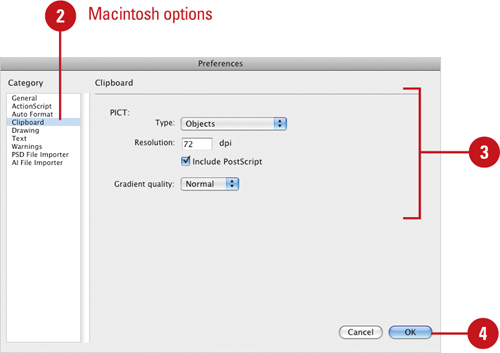1. Setting Text Preferences
When
you edit or work with text in a Flash document, you can specify text
related preferences. You can select a font to use when substituting
missing fonts, or select text orientation options, which is useful when
using English (horizontal) or Asian (vertical) language fonts. In
addition, you can select a language as an input method.
Set Text Preferences
1. Click the Flash (Mac) or Edit (Win) menu, and then click Preferences.
|
2. Click the Text category.
 |
3. Select from the following options:
Show Asian Text Options. Select to show Asian text options in the Property Inspector (New!). Show Right-To-Left Text Options. Select to show Direction options in the Property Inspector (New!). Font Mapping Default. Click the list arrow, and then select a font to use when substituting missing fonts. Click the Style list arrow, and then select a font style. Show For Missing Fonts. Select to show the Font Mapping dialog box. Vertical Text options. Default Text Orientation. Select to make default orientation vertical, which is useful for Asian fonts. Right To Left Text Flow. Select to reverse the default text direction. No Kerning. Select to turn off kerning for vertical text.
Input Method. Select the Text Input Window check box (Mac) or language option to select a language type. Font Menus. Select check boxes and option to show fonts in menus.
|
4. Click OK. |
2. Setting Clipboard Preferences
When
you copy or cut graphics to the Clipboard, you can set preferences to
determine how you want to paste the graphic into a Flash document. The
preference options give you control over the size and quality of the
graphics you insert in a document. If you are using Windows, the
Clipboard preferences include options for bitmaps and gradients in the
Windows Metafile format. If you are using a Macintosh, the Clipboard
preferences include options for the PICT format.
Set Clipboard Preferences
1. Click the Flash (Mac) or Edit (Win) menu, and then click Preferences.
|
2. Click the Clipboard category.
 |
3. Select from the following options:
- Bitmaps (Win). Select options
for Color Depth and Resolution to specify these parameters for bitmaps
copied to the Clipboard. Select Smooth to apply anti-aliasing. Enter a
value in the Size Limit box to specify the amount of RAM that is used
when placing a bitmap on the Clipboard.
- PICT Settings (Mac).
Select Objects to preserve data copied to the Clipboard as a vector
graphic, or select one of the bitmap formats to convert the image. Enter
a value for Resolution. Select the Include Postscript check box to
include Postscript data. For gradients, select an option to specify
quality in the PICT.
- Gradient quality. Select an option to specify the quality of gradient fills placed in the Windows Metafile.

|
4. Click OK. |